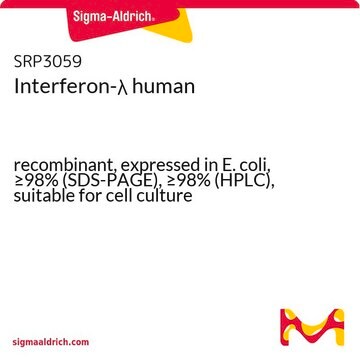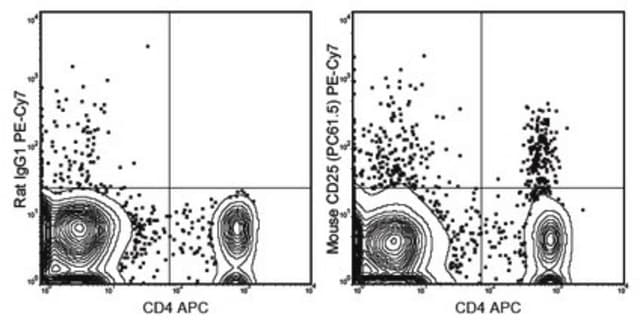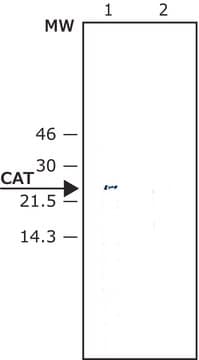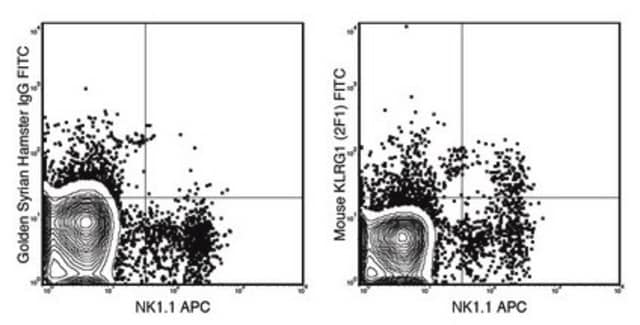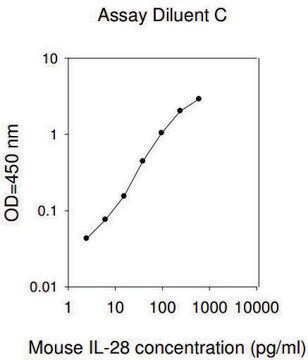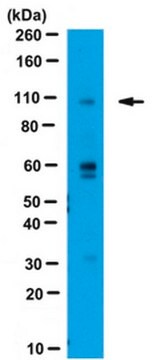MABF227
Anti-Interferon Lambda 4, clone 4G1 Antibody
clone 4G1, 1 mg/mL, from mouse
Sinonimo/i:
Interferon lambda-4, IFN-lambda-4
About This Item
Prodotti consigliati
Origine biologica
mouse
Livello qualitativo
Forma dell’anticorpo
purified immunoglobulin
Tipo di anticorpo
primary antibodies
Clone
4G1, monoclonal
Reattività contro le specie
nonhuman primates, human
Non deve reagire con
porcine, giant panda, canine, bat, bovine
Concentrazione
1 mg/mL
tecniche
ELISA: suitable
flow cytometry: suitable
immunocytochemistry: suitable
immunohistochemistry: suitable
western blot: suitable
Isotipo
IgG1κ
N° accesso NCBI
N° accesso UniProt
Condizioni di spedizione
wet ice
modifica post-traduzionali bersaglio
unmodified
Informazioni sul gene
bat ... Loc102244039(102244039)
human ... IFNL4(101180976)
Descrizione generale
Specificità
Immunogeno
Applicazioni
ELISA Analysis: A representative lot was conjugated with a sulfo-tag (MSD) and employed as the detection antibody in a sandwich ELISA application. An exogenously expressed IFNL4 HaloTag fusion was found secreted in the culture media from IFNL4-Halo construct-transfected, but not mock-transfected HepG2 cells (Onabajo, O.O., et al. (2015). J. Interferon. Cytokine Res. 35(11):888-900).
Flow Cytometry Analysis: A representative lot immunostained HepG2 cells transfected to express HaloTag fusion IFN-λ4 orthologs of elephant, human and non-human primate (chimpanzee, orangutan, rhesus, marmoset, cynomolgus) origins, but not cells expressing IFNL4 of bovine, bat, canine, panda, and porcine species (Paquin, A., et al. (2016). J. Interferon Cytokine Res. 36(1):30-36).
Immunocytochemistry Analysis: Representative lots immunostained HepG2 cells transfected to express HaloTag fusion of IFN-λ4 orthologs of elephant, human and non-human primate (chimpanzee, orangutan, rhesus, marmoset, cynomolgus) origins (Paquin, A., et al. (2016). J. Interferon Cytokine Res. 36(1):30-36; Prokunina-Olsson, L., et al. (2013). Nat. Genet. 45(2):164-171).
Immunocytochemistry Analysis: A representative lot detected a time-dependent induction of IFNL4 expression in hepatocytes from a donor heterozygous for ss469415590 (TT/ΔG) upon PolyI:C treatment or hepatitis C virus (HCV) strain JFH1HCV infection in cultures (Prokunina-Olsson, L., et al. (2013). Nat. Genet. 45(2):164-171).
Western Blotting Analysis: A representative lot detected HaloTag fusion IFN-λ4 orthologs of elephant, human and non-human primate (chimpanzee, orangutan, rhesus, marmoset, cynomolgus) origins, but not IFNL4 of bovine, bat, canine, panda, and porcine species transiently expressed in HepG2 cells (Paquin, A., et al. (2016). J. Interferon Cytokine Res. 36(1):30-36).
Western Blotting Analysis: A representative lot detected exogenously expressed IFNL4 HaloTag fusion constructs in transfected COS-7 and HepG2 cells, but not in untransfected cells. Clone 4G1 does not cross-react with IFN-alpha or IL-28B (Prokunina-Olsson, L., et al. (2013). Nat. Genet. 45(2):164-171).
Qualità
Western Blotting Analysis: 1.0 µg/mL of this antibody detected 0.1 µg of human IFNL4 recombinant protein.
Descrizione del bersaglio
Stato fisico
Not finding the right product?
Try our Motore di ricerca dei prodotti.
Codice della classe di stoccaggio
12 - Non Combustible Liquids
Classe di pericolosità dell'acqua (WGK)
WGK 1
Punto d’infiammabilità (°F)
Not applicable
Punto d’infiammabilità (°C)
Not applicable
Certificati d'analisi (COA)
Cerca il Certificati d'analisi (COA) digitando il numero di lotto/batch corrispondente. I numeri di lotto o di batch sono stampati sull'etichetta dei prodotti dopo la parola ‘Lotto’ o ‘Batch’.
Possiedi già questo prodotto?
I documenti relativi ai prodotti acquistati recentemente sono disponibili nell’Archivio dei documenti.
Il team dei nostri ricercatori vanta grande esperienza in tutte le aree della ricerca quali Life Science, scienza dei materiali, sintesi chimica, cromatografia, discipline analitiche, ecc..
Contatta l'Assistenza Tecnica.

